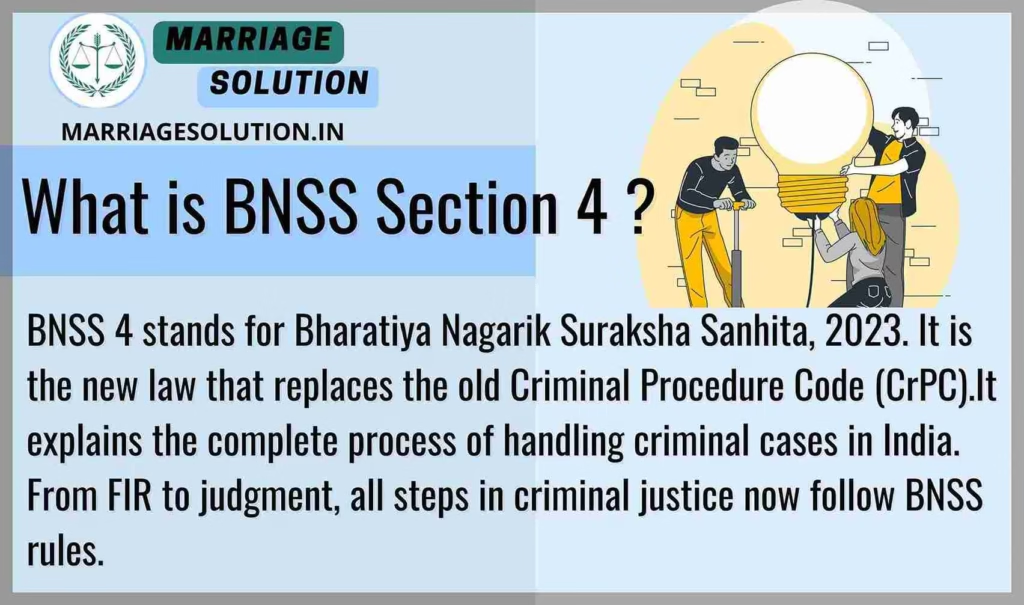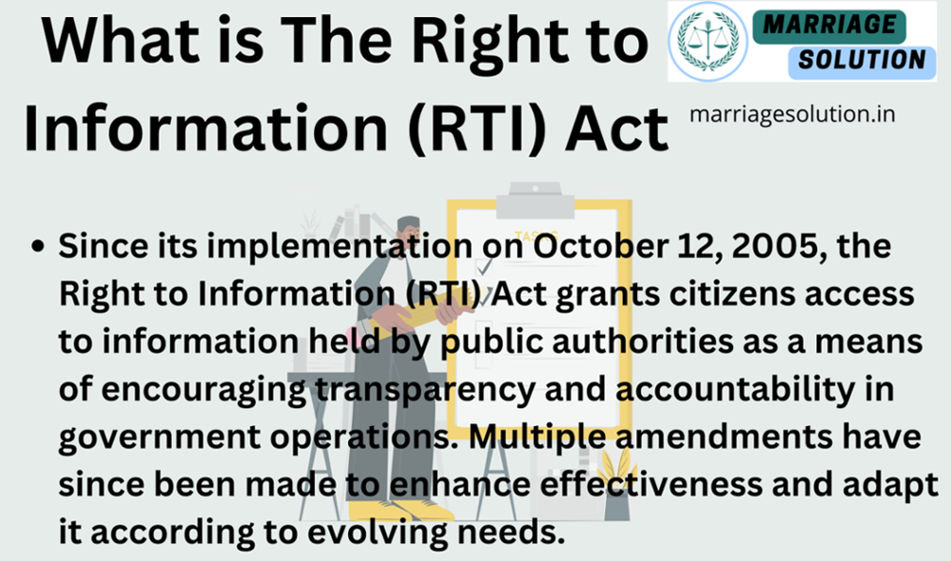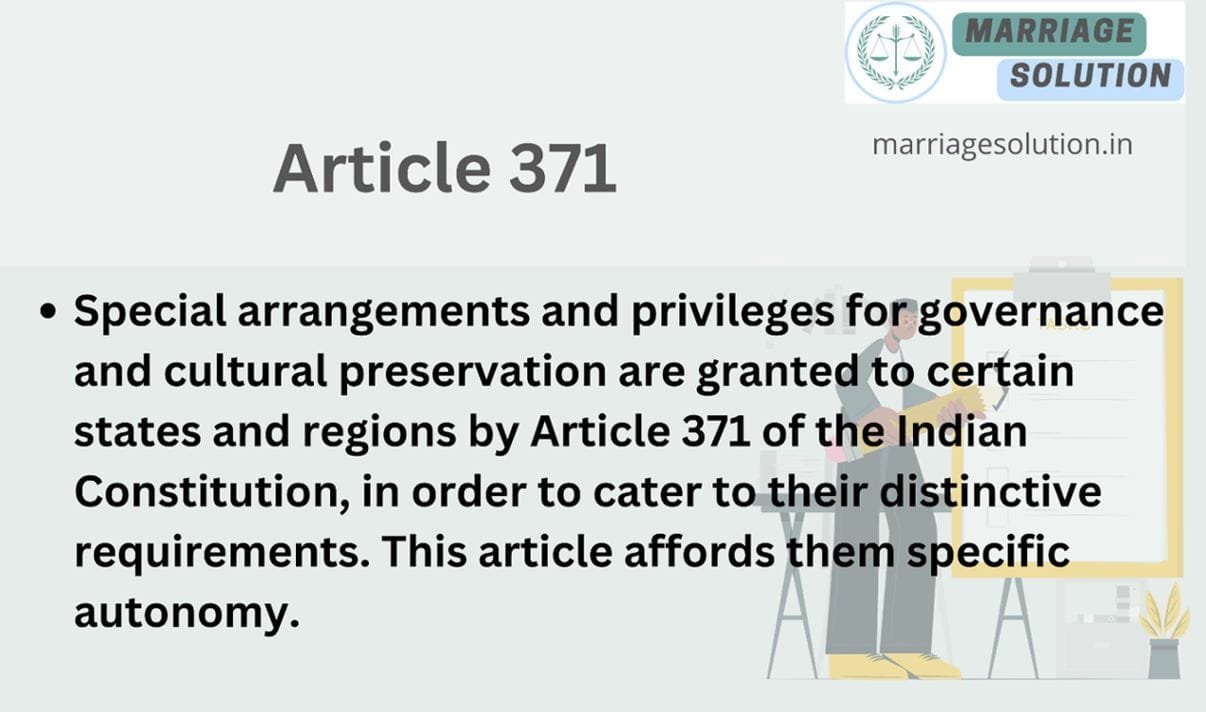Introduction of Section 4 of BNSS
BNSS Section 4 tells us how offences (crimes) under BNSS and other Indian laws should be handled. It clearly says that all cases, whether under BNSS or any other law, must be investigated, inquired into, tried, and completed according to the rules given in BNSS. If any other special law has its own method, that will be followed too. This section brings unity and clarity in the criminal process across India.
What is BNSS Section 4 ?
BNSS 4 stands for Bharatiya Nagarik Suraksha Sanhita, 2023. It is the new law that replaces the old Criminal Procedure Code (CrPC).It explains the complete process of handling criminal cases in India.
From FIR to judgment, all steps in criminal justice now follow BNSS rules.

BNSS Section of 4 in Simple Points
🔹 1. BNSS applies to all offences under the new law
BNSS Section 4 clearly says that all crimes under the Bharatiya Nyaya Sanhita, 2023 must follow the procedure written in this law. From the time of police investigation to the final court trial, the BNSS will be used. This means all steps, like collecting evidence, filing charges, and passing judgments, must follow BNSS. It ensures uniform justice for all citizens. Police, lawyers, and judges will follow the same system. It replaces the old criminal procedure code. This brings transparency and fairness in legal matters. Everyone will get justice in the same manner.
🔹 2. BNSS also applies to offences under other laws
BNSS is not just limited to Bharatiya Nyaya Sanhita offences. It also applies to crimes listed in other laws like the Drugs Act, Cyber Law, or POCSO Act. But if those laws have their own rules for handling crimes, then those special rules will be followed. So BNSS works as a base system. It steps in when the other law does not explain the process. This makes the justice system smoother. It avoids confusion between different legal procedures. BNSS works like a helping hand for all other criminal laws.
🔹 3. It covers full process: from FIR to judgment
This section tells us that all stages of a criminal case – investigation, inquiry, trial, and final decision – will follow BNSS rules. Investigation means police checking the case. Inquiry means the court checking the facts. Trial means the full hearing in court. And dealing with the case means giving punishment or relief. BNSS gives clear rules for each stage. This avoids delay and confusion. Everyone knows what steps to follow. It makes the system more efficient and people-friendly.
🔹 4. BNSS respects other special criminal laws
If another law like the Juvenile Justice Act or NDPS Act has its own procedure, then that special procedure will be used. BNSS does not cancel or interfere with them. It only applies where those laws do not give a clear process. This shows that BNSS supports other important laws. It helps fill the gap where needed. Courts will check each case to decide which law to apply. This flexible rule keeps the justice system fair. It balances power between different laws.
🔹 5. BNSS Section 4 improves legal uniformity
Earlier, different states and courts followed different rules based on CrPC. BNSS now gives a single set of rules for the whole country. This means crimes will be handled the same way everywhere in India. Whether the case is in Delhi or Mumbai, the law stays the same. This creates fairness in the justice system. It helps citizens understand their rights. It also improves the speed of cases. Uniformity is the first step to stronger and clearer justice for all.
Section 4 of BNSS Overview
🔹 1. BNSS is the default criminal procedure
BNSS Section 4 makes it clear that all crimes under the Bharatiya Nyaya Sanhita, 2023 must follow the rules written in this law. From the moment a crime is reported, till the final court decision, the BNSS procedures will apply. This includes investigation by police, filing of charge sheets, conducting trials, and passing judgments. It helps ensure that every stage of a criminal case follows a clear path. This gives confidence to police, courts, and citizens about the law. It replaces old laws with updated, simplified procedures. BNSS acts as the standard operating manual for all criminal cases. The goal is to create fairness and uniformity in justice delivery.
🔹 2. Applies to all Indian laws unless specially stated
Even if a crime is defined under another Indian law (like NDPS Act or IT Act), BNSS Section 4 will apply. However, if that special law has its own procedure, then that law will be followed instead. So, BNSS is the default, but it can step aside if another valid law takes over. This helps avoid conflicts between laws. For example, juvenile crimes follow the Juvenile Justice Act, not BNSS. BNSS Section 4 respects the authority of other Acts. It only fills in the gap where those Acts don’t have their own process.
🔹 3. Uniformity across the country
BNSS Section 4 ensures that there is one uniform procedure for handling crimes all over India. Whether a crime happens in Delhi or Tamil Nadu, the investigation, trial, and punishment will follow the same pattern. This creates a fair and balanced system for all citizens. Earlier, some states followed different practices under CrPC. BNSS ends that confusion. Uniformity improves trust in the criminal justice system. Citizens and police know what to expect. This also helps lawyers, judges, and investigating agencies work efficiently.
🔹 4. Helps both old and new cases
BNSS Section 4 can also apply to older cases if the trial is still ongoing after the law came into force. This means the law is not limited to future crimes only. Courts can decide whether to continue with the old law or apply BNSS, depending on the situation. If there is no major conflict, the BNSS will likely apply. This helps in a smooth transition from old laws to the new system. It avoids confusion and gives courts flexibility. The aim is to serve justice fairly without delays.
🔹 5. Defines every stage: Investigation to trial
This section clearly covers four major stages: Investigation, Inquiry, Trial, and dealing with the offence. “Investigation” means the police gather proof. “Inquiry” refers to checking the facts in court. “Trial” is the formal court hearing where a verdict is given. And “dealing with” includes punishment or appeal. BNSS Section 4 ensures that all these stages follow a standard pattern. It avoids missteps that can delay justice. Everyone involved knows their role and limits. This clarity is very important in criminal law.
🔹 6. Special laws can override BNSS
If another law clearly has its own rules for investigation or trial, that law will take priority. BNSS does not cancel or stop those laws. For example, the POCSO Act has its own procedures to protect children. BNSS respects those unique rules. It only applies when there’s no other system provided. This makes the BNSS flexible and supportive of other useful laws. Courts will check each case and decide which rule applies. This keeps the justice system smart and case-specific.
🔹 7. Helps police, prosecutors, and courts
BNSS Section 4 works like a guidebook for all stakeholders in the criminal justice system. Police officers know what rules to follow during arrest and evidence collection. Prosecutors can confidently prepare the case as per BNSS. Judges get a clear roadmap for trials. This prevents mistakes and confusion in legal procedures. When everyone follows the same book of law, cases move faster. It improves coordination between departments. Citizens also benefit from quicker and fairer results.
🔹 8. Creates consistency in justice
Earlier, some cases followed CrPC, and others followed different rules. This created delays, appeals, and confusion. BNSS Section 4 solves this by creating consistency in how crimes are handled. Every case goes through the same system unless a special rule applies. This helps in delivering uniform justice. Two people in similar crimes will get similar treatment. It reduces bias and legal uncertainty. A consistent system is the backbone of a strong legal framework.
🔹 9. BNS procedure is detailed and complete
BNSS does not just give vague instructions. It has detailed steps for every part of the criminal process. From FIR registration to bail and evidence handling, everything is mentioned. Section 4 ensures all those steps are used properly. So, if someone is wrongly arrested or a trial is delayed, courts can refer to BNSS for correction. It strengthens the rights of both victims and accused. A detailed procedure helps avoid human error. It protects justice through structure.
🔹 10. Important for legal reforms in India
BNSS Section 4 represents a big step in India’s legal reform. It replaces the old British-era criminal code (CrPC) with a modern, people-friendly process. The section ensures a smooth shift into the new system. It connects BNSS to other laws without creating conflict. It will help reduce backlog in courts and increase conviction rates by making procedures simpler. This is essential for India’s growing democracy. A clear, fast, and fair justice system is the foundation of good governance.
Examples of BNSS Section 4
✅ Example 1: Theft under BNSS
Ramesh is caught stealing a mobile phone. Since theft is covered under BNSS, the police will follow BNSS rules for investigation. The trial will also happen as per BNSS Section 4 guidelines.
✅ Example 2: Cybercrime under IT Act
Priya files a case of cyberbullying under the Information Technology Act. BNSS Section 4 will apply for investigation and trial unless the IT Act has any specific rules. If IT Act has no special rule, BNSS rules will be followed.
Section 4 of BNSS Short Information
| Point | Details |
|---|---|
| Section | BNSS Section 4 |
| Topic | Trial of offences under BNS and other laws |
| Applies to | All offences under BNS and other Indian laws |
| Main Rule | BNS procedures apply to all cases unless another law provides otherwise |
| Purpose | To ensure consistency in how crimes are investigated and tried |
BNSS Section 4 FAQs
BNSS 4
If you need support with court proceedings or any other legal matters, don’t hesitate to reach out for assistance.
Court or any other marriage-related issues, our https://marriagesolution.in/lawyer-help-1/ website may prove helpful. By completing our enquiry form and submitting it online, we can provide customized guidance to navigate through the process.
Right to Information RTI act :Your Comprehensive Guide (Part 1)
The Right to Information (RTI) Act : Explore the essence of the Right to Information (RTI) Act through this symbolic image. The image features legal documents, emphasizing the importance of transparency and accountability in governance. The scales of justice represent…
What is Article 371 of Indian Constitution ?
Article 371 of the Indian Constitution grants special provisions to specific states and regions within India, addressing their unique historical, social, and cultural circumstances. These provisions aim to accommodate diverse needs and protect cultural identities within the constitutional framework.
Indian Labour law : Your Comprehensive Guide (Part 1)
The purpose of labour laws is to safeguard employees and guarantee equitable treatment at the workplace, encompassing aspects such as remuneration, security, and perks. These regulations establish a secure ambiance by imposing minimum wage requirements, ensuring factory safety measures are…
GST :Your Comprehensive Guide (Part 1 – Understanding the Basics)
The Goods and Services Tax (GST) is like a big change in how we pay taxes in India. It started on July 1, 2017, and it’s here to simplify things. Before GST, we had many different taxes, and it could…





